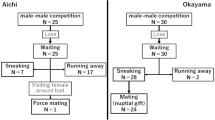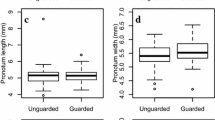Summary
One explanation for polygyny in pied flycatchers (Ficedula hypoleuca) is the deception hypothesis, which proposes that females mate with already-mated males only because they are unaware that such males already have a mate on another territory. Recently this hypothesis has been criticized on the grounds that already-mated and unmated males differ sufficiently in their behavior that human observers can discriminate between the two classes fairly easily. Here we test whether male pied flycatchers change their behavior when visited by a female so as to make this discrimination more difficult. In our experiments we presented a caged female near the nestbox of an advertising male, in order to mimic the situation in which a female investigates the male and his nest site. During control periods, when only an empty cage was presented, we found that already-mated males were present on their secondary territories significantly less and sang significantly less than unmated males on their primary territories, confirming the earlier results. When we presented the stimulus female, all behaviors we measured changed significantly relative to control periods for both mated and unmated males: both classes of males increased the time spent on the territory, decreased singing rates, and increased various courtship behaviors. During the experimental periods there were no significant differences between mated and unmated males on any of the behavioral measures. Discriminant analysis was more successful in classifying males as to mating status using data from the control periods (without female) than using data from the experimental periods (with female). We conclude that when a female is present male pied flycatchers change their behavior in ways that make it more difficult to discriminate mated from unmated males.
Similar content being viewed by others
References
Alatalo RV, Lundberg A (1984) Polyterritorial polygyny in the pied flycatcher Ficedula hypoleuca — evidence for the deception hypothesis. Ann Zool Fenn 21:217–228
Alatalo RV, Lundberg A (1986) The sexy son hypothesis: data from the pied flycatcher Ficedula hypoleuca. Anim Behav 34:1454–1462
Alatalo RV, Lundberg A (1990) Polyterritorial polygyny in the pied flycatcher. In Slater PJD, Rosenblatt JS, Beer C (eds) Advances in the Study of Behaviour, vol 19. Academic Press, San Diego, pp 1–27
Alatalo RV, Carlson A, Lundberg A, Ulfstrand S (1981) The conflict between male polygamy and female monogamy: the case of the pied flycatcher Ficedula hypoleuca. Am Nat 117:738–753
Alatalo RV, Lundberg A, Stahlbrandt K (1982) Why do pied flycatcher females mate with already-mated males? Anim Behav 30:585–593
Alatalo RV, Lundberg A, Stahlbrandt K (1984) Female mate choice in the pied flycatcher Ficedula hypoleuca. Behav Ecol Sociobiol 14:253–261
Alatalo RV, Lundberg A, Glynn C (1986) Female pied flycatchers Ficedula hypoleuca choose territory quality and not male characteristics. Nature 323:152–153
Alatalo RV Lundberg A, Ratti O (1990) Male polyterritoriality and imperfect female choice in the pied flycatcher, Ficedula hypoleuca. Behav Ecol 1:171–177
Askenmo CEH (1984) Polygyny and nest site selection in the pied flycatcher. Anim Behav 32:972–980
Breichagen T, Slagsvold T (1988) Male polyterritoriality and female-female aggression in pied flycatchers Ficedula hypoleuca. Anim Behav 36:604–606
Curio E (1959) Verhaltensstudien am Trauerschnapper; Beiträge zur Ethologic und Ökologie von Muscicapa h. hypoleuca Pallas. Z Tierpsychol Suppl 3:1–118
Dale S, Amundsen T, Lifjeld JT, Slagsvold T (1990) Mate sampling behavior of female pied flycatchers: evidence for active mate choice. Behav Ecol Sociobiol 27:87–91
Eriksson D, Wallin L (1986) Male bird song attracts females: a field experiment. Behav Ecol Sociobiol 19:297–299
Haartman L von (1951) Successive polygamy. Behaviour 3:256–274
Haartman L von (1956) Territory in the pied flycatcher (Ficedula hypoleuca). Ibis 98:460–475
Haartman L von (1969) Nest-site and evolution of polygamy in European passerine birds. Ornis Fenn 46:1–12
Haartman L von, Hilden O, Linkola P, Suomalainen P, Tenovuo R (1963) Pohjclan linnut varikuvin. Otava, Helsinki
Lifjeld JT, Slagsvold T (1986) The function of courtship feeding during incubation in the pied flycatcher Ficedula hypoleuca. Anim Behav 34:1441–1453
Lifjeld JT, Slagsvold T, Stenmark G (1987) Allocation of incubation feeding in a polygynous mating system: a study on pied flycatchers Ficedula hypoleuca. Anim Behav 35:1663–1669
Lloyd JE (1985) On deception, a way of all flesh, and firefly signalling and systematics. In: Dawkins R, Ridley M (eds) Oxford Surveys in Evolutionary Biology, vol 1. Oxford University Press, Oxford, pp 48–84
Mish FC (1986) (ed) Webster's Ninth New Collegiate Dictionary, Merriam-Webster, Springfield, Massachusetts
Ristau CA, Robbins D (1982) Cognitive aspects of ape language experiments. In: Griffin DR (ed) Animal Mind — Human Mind. Springer-Verlag, Berlin, pp 299–331
Searcy WA, Yasukawa K (1989) Alternative models of territorial polygyny in birds. Anim Behav 134:323–343
Slagsvold T (1986) Nest site settlement by the pied flycatcher: does the female choose her mate for the quality of his house or himself? Ornis Scand 17:210–220
Slagsvold T, Lifjeld JT, Stenmark G, Breiehagen T (1988) On the cost of searching for a mate in female pied flycatchers Ficedula hypoleuca. Anim Behav 36:433–442
Stenmark G, Slagsvold T, Lifjeld JT (1988) Polygyny in the pied flycatcher, Ficedula hypoleuca: a test of the deception hypothesis. Anim Behav 36:1646–1657
Temrin H (1991) Deceit of mating status in passerine birds: an evaluation of the deception hypothesis. Current Ornithol (in press)
Woodruff G, Premack D (1979) Intentional communication in the chimpanzee: the development of deception. Cognition 7:333–362
Author information
Authors and Affiliations
Additional information
Offprint requests to: W.A. Searcy
Rights and permissions
About this article
Cite this article
Searcy, W.A., Eriksson, D. & Lundberg, A. Deceptive behavior in pied flycatchers. Behav Ecol Sociobiol 29, 167–175 (1991). https://doi.org/10.1007/BF00166398
Received:
Accepted:
Issue Date:
DOI: https://doi.org/10.1007/BF00166398




